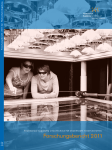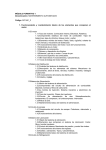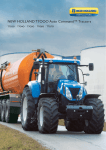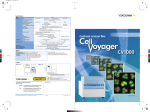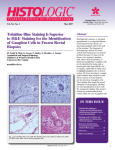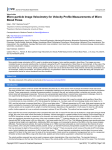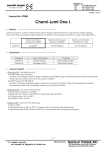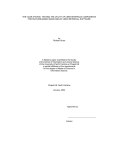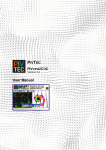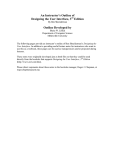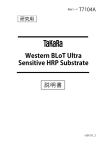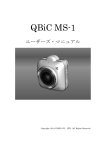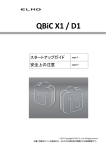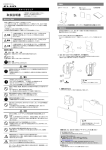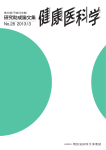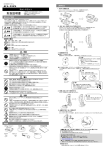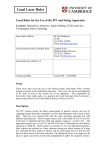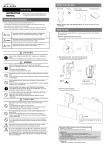Download Advanced CUBIC protocols for whole-brain and whole
Transcript
PROTOCOL Advanced CUBIC protocols for whole-brain and whole-body clearing and imaging Etsuo A Susaki1–3,7, Kazuki Tainaka1–3,7, Dimitri Perrin4,7, Hiroko Yukinaga3, Akihiro Kuno1,2,5,6 & Hiroki R Ueda1–3 1Department of Systems Pharmacology, The University of Tokyo, Tokyo, Japan. 2Japan Agency for Medical Research and Development (AMED) – Core Research for Evolutionary Science and Technology (CREST), AMED, Tokyo, Japan. 3Laboratory for Synthetic Biology, RIKEN Quantitative Biology Center (QBiC), Osaka, Japan. 4School of Electrical Engineering and Computer Science, Science and Engineering Faculty, Queensland University of Technology (QUT), Brisbane, Queensland, Australia. 5Department of Anatomy and Embryology, Faculty of Medicine, University of Tsukuba, Ibaraki, Japan. 6PhD Program in Human Biology, School of Integrative and Global Majors, University of Tsukuba, Ibaraki, Japan. 7These authors contributed equally to this work. Correspondence should be addressed to H.R.U. ([email protected]). © 2015 Nature America, Inc. All rights reserved. Published online 8 October 2015; doi:10.1038/nprot.2015.085 Here we describe a protocol for advanced CUBIC (Clear, Unobstructed Brain/Body Imaging Cocktails and Computational analysis). The CUBIC protocol enables simple and efficient organ clearing, rapid imaging by light-sheet microscopy and quantitative imaging analysis of multiple samples. The organ or body is cleared by immersion for 1–14 d, with the exact time required dependent on the sample type and the experimental purposes. A single imaging set can be completed in 30–60 min. Image processing and analysis can take <1 d, but it is dependent on the number of samples in the data set. The CUBIC clearing protocol can process multiple samples simultaneously. We previously used CUBIC to image whole-brain neural activities at single-cell resolution using Arc-dVenus transgenic (Tg) mice. CUBIC informatics calculated the Venus signal subtraction, comparing different brains at a whole-organ scale. These protocols provide a platform for organism-level systems biology by comprehensively detecting cells in a whole organ or body. INTRODUCTION Since the discovery of the cell as the basic unit of living organisms, people have been seeking a way to observe all cells inside the body. Comprehensive analysis of cells in organs and whole organisms is expected to provide information about type, position, number and activity of cells and cellular networks. Tissue clearing followed by 3D imaging is one approach that enables the analysis of multiple cells simultaneously in organs. Thus, the development of this and related technologies has become a recent trend1,2. Development of tissue-clearing methods Early tissue-clearing methods used organic chemicals (e.g., benzyl alcohol–methyl salicylate, benzyl alcohol–benzyl benzoate (BABB), and solvents used in 3D imaging of solvent-cleared organs (3DISCO)) for this purpose3–6. Some of these methods achieved high transparency within a few days by removing lipids and homogenizing refractive indices (RIs) of the tissue, and they were shown to be compatible with whole-mount immunohistochemical analysis7. However, concerns about the quenching of fluorescent proteins and safety issues led to further method development. A recent publication addressed this issue, reporting that pH control and temperature during clearing are crucial to stabilizing fluorescent proteins8. Alternative techniques, such as Scale9, use a hydrophilic chemical urea, and more recently developed tissue-clearing methods use other hydrophilic reagents, including SeeDB10, ClearT (ref. 11), or 2,2`-thiodiethanol12,13 and FRUIT14. These methods are easy and safe, and they allow fluorescent signals to be retained; however, they have a relatively low clearing capability. The introduction of CLARITY enabled both fluorescence retention and high transparency by embedding a tissue into hydrogel polymer and removing most of the lipids by electrophoresis15. Possible drawbacks of CLARITY included its technical difficulty and limited scalability because of the need to use a specific device. However, these difficulties have been addressed by the development of passive clearing protocols that increased the scalability16,17. In this protocol, we describe how to perform CUBIC. CUBIC offers a high-performance and device-free tissue clearing method based on hydrophilic reagents, which preserves fluorescence. It enables reproducible whole-organ and wholebody clearing. We have used CUBIC for clearing and rapid 3D imaging of whole mouse brains, a whole marmoset hemisphere, whole mouse organs (e.g., lung and heart) and whole mouse body. These images were used for image analyses for extracting biological information18,19. Methods for imaging cleared tissues Tissues cleared using the above methods can be imaged in 3D with optical microscopies. Because some of the above clearing methods render tissues highly transparent, light-sheet fluorescence microscopy (LSFM) has also been used for imaging1,2. This type of microscopy can collect z-stack images in a rapid manner, and it has been applied to 3D and 4D imaging, such as a time-lapse imaging of developing embryos or whole-brain calcium dynamics20–23. One of the earliest cases of whole mouse brain imaging was rapid whole-brain imaging of a BABB-cleared brain using a macrozoom-compatible light-sheet unit (ultramicroscopy)4. More recently, COLM (CLARITY-optimized lightsheet microscopy) has been used for whole-brain-scale imaging of CLARITY-processed brains16. Thus, the use of LSFM after an efficient tissue-clearing method facilitates a high-throughput collection of multiple 3D images. Rapid 3D imaging with LSFM can be used after whole-organ and whole-body clearing by CUBIC. CUBIC also provides processing and analysis of 3D images for extracting biological NATURE PROTOCOLS | VOL.10 NO.11 | 2015 | 1709 PROTOCOL © 2015 Nature America, Inc. All rights reserved. information. Therefore, CUBIC presents a platform of wholeorgan or whole-body imaging and image informatics, which enables a wide range of users to perform experiments targeting cellular and organ layers with multiple samples. Development of CUBIC for efficient and reproducible whole-organ or whole-body clearing In developing a clearing technique for whole-brain and wholebody imaging, we considered two main criteria: one, efficiency and transparency with the preservation of fluorescence for a rapid whole-brain/body imaging with LSFM, and, two, reproducibility for comparative analysis of multiple samples . Because a clearing method with hydrophilic reagents had the potential to fulfill these criteria, we started by modifying the Scale recipe9. For this purpose, we constructed a new chemical screening method in which reduction of turbidity of a fixed-brain suspension was measured before and after mixing with a candidate chemical solution 18. This screening enables nonbiased discovery of brain-clearing chemicals. We screened 40 Scale-related chemicals and found that aminoalcohols, in addition to urea and Triton X-100 in Scale, clear tissue with minimal fluorescence quenching18. In the CUBIC clearing protocol, we prepared two reagents, ScaleCUBIC-1 (reagent-1) and ScaleCUBIC-2 (reagent-2), which also minimize light scattering inside the tissue. The first reagent works as a potential lipid remover. Lipid is thought to be the main lightscattering material inside tissue, and its removal is correlated with the degree of transparency. A fixed brain was treated with the first reagent for ~1 week, washed with buffer and then immersed into the second reagent, which has an RI close to ~1.49, which is similar to that of the SeeDB reagent10. Moving from the buffer to the second reagent matched the RIs between the sample and the reagent, which further-reduced light scattering within the tissue. Thus, a whole mouse brain became transparent within ~14 d (ref. 18). However, some chemicals seem to have additional or different roles during the procedure, and thus further studies are needed to elucidate tissue-clearing mechanisms. In addition to light scattering, light absorption is another challenge in tissue clearing. We accidentally found that aminoalcohols can remove heme in blood and tissues19; thus, CUBIC is able to decolorize tissue. We used perfusion of the CUBIC reagent (CB-perfusion) to efficiently penetrate the mouse body and to accelerate the clearing and decoloring procedure. The CBperfusion protocol enabled not only faster clearing of dissected tissues but also whole-body clearing of infant and adult mice19. Because of its efficiency and reproducibility, the CUBIC protocol can be applied to multiple samples in a single experiment, and it is scalable from subcellular structures (e.g., neuronal axons or spines) to marmoset brains to whole animal bodies 18,19. Furthermore, whole-organ counterstaining with a nucleic dye enables precise positioning of genetically labeled cells in the whole-organ structure, extraction of specific anatomical structures and alignment of different samples for comparing signal intensities18,19. CUBIC for whole-organ or whole-body imaging and image informatics CUBIC-cleared samples can be used in LSFM. We use an optimized Ultramicroscope (LaVision BioTec) for this purpose. In rapid whole-organ imaging, a single, cleared, whole mouse 1710 | VOL.10 NO.11 | 2015 | NATURE PROTOCOLS brain can be imaged within 30–60 min per color and orientation. Fluorescence wavelength affects the quality of imaging results; in general, red wavelengths can penetrate deeper in tissue, and thus better imaging results are obtained with red fluorescence than green fluorescence, particularly in deeper regions. To ensure that weaker signals are detected in deeper regions, the sample is imaged in two orientations; in the case of whole-brain imaging, we took z-stack images of the dorsal-side-up (D-V) and ventralside-up (V-D) directions. Image visualization software such as Imaris can be used for depicting the reconstituted 3D image. Imaris implements numerous image analysis functions including spot counting and surface extraction. We performed extractions of anatomical structures in the 3D images for comparison of Langerhans islets in normal and diabetic pancreases19. For more complicated analyses, we implemented image informatics often used in functional MRI (fMRI) analysis18. First, structural images via counterstaining were registered to a reference brain to calculate transformation parameters. Next, the transformation parameters were applied to the corresponding signal images (transgenes, etc.) for alignment. These aligned images could be merged with each other to calculate signal subtraction between samples. This analysis was performed with open-source software such as Advanced Normalization Tools (ANTS)24 and ITK-SNAP25, but it requires advanced informatics and computer science skills. For the user’s convenience, we provide an easier analysis pipeline with prepared scripts in this manuscript. As an example of the comparative analysis, we demonstrate 3D image analysis of Arc-dVenus Tg mouse brains with or without light stimulation and calculate the signal subtraction18,26. The final subtraction data clearly depict regions and cells in the whole brain in which neurons responded to the light stimuli. Such direct comparative analysis by using whole-brain fluorescent 3D images was first reported using CUBIC informatics18. CUBIC informatics enables quantitative identification of stimulus- or timing-dependent neural activities, and it will help delineate structural abnormalities in disease samples at the wholeorgan and whole-body scale. Overview of the CUBIC pipeline CUBIC provides a platform for a comprehensive analysis of cells in a whole organ or body. Here we focus on describing the following: (i) the advanced CUBIC clearing protocols by simple immersion and CB-perfusion (Steps 1–2); (ii) whole-brain and whole-organ imaging with a LSFM (Steps 3–6); and (iii) CUBIC informatics for preprocessing and comparison of different brain samples (Steps 7–15, see also Fig. 1). Although CUBIC is also applicable to staining with small chemicals or antibodies over days to weeks, as described previously18,19, we focus here on imaging of fluorescent proteins together with nuclear counterstaining. Tissue clearing. Here we provide three clearing procedures: Step 2A, a simple immersion protocol for dissected whole organs; Step 2B, the CB-perfusion and immersion protocol for faster clearing of whole organs; and Step 2C, the CB-perfusion protocol for whole-body clearing. The immersion protocol in our first CUBIC report18 has been improved to an advanced version (Fig. 2) in which the clearing speed and efficiency are increased. The CB-perfusion protocol (Fig. 3) is almost identical to that in our second CUBIC report19, but more detail is given here. PROTOCOL Two-photon imaging, etc. Clearing by simple immersion Day 0 Day 1 Days 2–8 Fixation Lipid removal RI matching Step 1–2A(ii) Step 2A(iii–vi) Step 2A(ii,iii) Step 2B(v–vii) Step 2B(viii,ix) Clearing by CB-perfusion Imaging with LSFM Steps 3–6 5–10 min 1d Perfused with PBS and 4% PFA Postfixation in 4% PFA 1–7 d Dissected organs Steps 1–2C(i) Day 8 7d Whole body Day 15~ 1d 7d Reagent-1 refresh/1 d Preprocessing Immersion oil Reagent-1 refresh/2–3 d Signal subtraction Steps 9 and 10 Acquision Steps 11 and 12 D-V images Use dorsal side Create composite NIfTI-1 data (viewed in ITK-SNAP) Immersion oil Lipid removal/decolorization Step 2C(ii,iii) 30 min~ Steps 7 and 8 Raw TIFF ~10 min Reagent-2 refresh/1 d Wash Day 1 Fixation / CB-perfusion Steps 1–2B(iv) 2d ~1 d Reagent-1 refresh/2–3 d Perfused with PBS, 4% PFA and 1/2-diluted reagent-1 Image analysis ~Day 11 1–3 h per sample Day 0 © 2015 Nature America, Inc. All rights reserved. ~Day 9 Acquision V-D images Steps 13–15 Sample A Sample B Reference Structure Subtracted Use ventral side Signal ~20 min ~3.5 h ~3 h 0.5–1.5 h Convert to NIfTI-1/ downscaling Create D-V + V-D composite Alignment Normalization and subtraction between samples Figure 1 | Overview of the CUBIC pipeline. CUBIC is composed of three major stages (clearing, imaging and analysis). For efficient and reproducible clearing, we provide three protocols: a simple immersion protocol (Step 2A), which takes ~11 d for a whole brain from an adult mouse (but varies according to the experimental purpose and organs); a CB-perfusion protocol for the whole adult mouse (Step 2C), which takes ~14 d; and the CB-perfusion and immersion hybrid protocol (Step 2B), in which dissected organs after CB-perfusion can be continuously cleared according to the simple immersion protocol. Rapid 3D imaging can be performed with an LSFM. The collected data are processed and analyzed, such as by signal comparison between samples, as described in this manuscript. Images of actual samples correspond to the samples in Figures 2 and 3. All animal experiments here were approved by the Animal Care and Use Committee of the RIKEN Kobe Institute and The University of Tokyo, and all animals were cared for in accordance with institutional guidelines. The clearing performance of CB-perfusion surpasses the immersion protocol, particularly in heme-rich organs (heart, muscle, kidney or liver)19, but it tends to cause decreased signal intensity because of a short fixation time. Incubation period can be varied, and it is dependent on the organ and imaging methods to be used (Figs. 1–3). Users may select either of these options and determine the desired final transparency for their experimental purposes. In either option, a paraformaldehyde (PFA) fixation is needed. Thus, animals are transcardially perfused with 4% (wt/vol) PFA, and then organs are dissected for postfixation (Step 1). Alternatively, the fixed body can be further perfused with diluted reagent-1. Samples are subsequently treated with reagent-1 and reagent-2. Counterstaining is performed during and after reagent-1 treatment18,19. Samples can be stored at various points in the PROCEDURE, which are indicated as PAUSE POINTS. Whole-organ or whole-body imaging. We use a commercially available LSFM instrument (Ultramicroscope, LaVision BioTec) supplied with an optimized macrozoom microscope (MVX-ZB10, Olympus) and a scientific complementary metal oxide semiconductor (sCMOS) camera (Andor NEO 5.5, 2,560 × 2,160 pixels). A customized sample holder is also used for larger brain and body samples and soft abdominal organs (Fig. 4). A suitable pair of excitation laser and emission filters is also installed. We typically use 100 mW of 488-nm laser-ET525/50 emission filter for green fluorescence, and 50 mW of 588-nm laser-ET650/60 emission NATURE PROTOCOLS | VOL.10 NO.11 | 2015 | 1711 PROTOCOL a b c d Pancreas Spleen Kidney © 2015 Nature America, Inc. All rights reserved. Complete dissolution Before dissolution structural images via whole-organ counterstaining should be collected. To ensure sharpness of signals throughout the 3D image, data of the same sample from different directions (D-V and V-D, in the case of whole-brain imaging) are also collected. This is recommended because the ventral horizontal slices are sharper in V-D images and dorsal horizontal slices are sharper in PBS washed 1/2 reagent-2 1/2 reagent-1 Reagent-1 Reagent-2 e Fixed brain D-V images (Fig. 5)18. (day 8 and 9) (day 9, 6.5 h) (day 1) (day 1, 6 h) (day 7) (day 11) If a proper LSFM instrument is not available, widely used confocal or twophoton microscopes can also be used. Partially cleared samples by one-step immersion in reagent-1 for 1–3 d are even applicable to deep region imaging with two-photon microscopy18, because the Figure 2 | Procedure of the simple immersion protocol. (a) Preparation of reagent-2. This reagent clearing performance surpasses that of some contains a high concentration of urea (25 wt%) and sucrose (50 wt%; top). These can be completely of the other clearing methods developed dissolved by heat and stirring with a microwave and a hot stirrer (bottom). (b) A vacuum desiccator for the degassing steps. (c) An incubator with a shaker (a hybridization incubator) that we use for the for these imaging purposes19. Microscope clearing procedure. Inset: five brain samples treated with reagent-1 in a single tube (day 5). (d) A table vendors have released objective lenses shaker used for the PBS washing step at room temperature. (e) Appearance of a brain sample in each step. for deep tissue imaging (e.g., Olympus A brain from C57BL/6 male mouse (8 weeks old) was used. Reagent-1–treated sample is temporally XLPLN10XSVMP, 10×/0.6, working swollen, but the size is recovered after immersion in reagent-2. Scale bar, 5 mm. All animal experiments distance (WD) = 8 mm, ne (adjustable were approved by the Animal Care and Use Committee of the RIKEN Kobe Institute and The University of refractive index range) = 1.33–1.52 and Tokyo, and all of the animals were cared for in accordance with institutional guidelines. XLSLPLN25XGMP, 25×/1.0, WD = 8 mm, ne = 1.41–1.52; Zeiss LD Plan-Aphochromat filter for red to far-red fluorescence. The size of the acquired image 20×1.0 WD = 5.6 mm, ne = 1.43–1.47; Leica HC FLUOTAR per pixel is dependent on the zoom of the microscope, such that L25×/1.00, WD = 6 mm, ne = 1.457). one pixel is ~5.2 × 5.2 Mm at 2× zoom and one pixel is ~6.5 × a b PFA perfusion CB-perfusion 6.5 Mm at 1.6× zoom. These pixel sizes are sufficient for detectPeristaltic pump ing signal from single cells in regions such as the cerebral cortex, or even from subcellular structures when they were 4% PFA Butterfly sparsely labeled, as discussed below (Fig. 4b–f and Supplementary needle Video 1). Users can also use higher magnified zoom values (~6.3×) if finer resolution is needed. Z-step size is selected according to PBS/heparin the thickness of the laser sheet. We typically select the thinnest 1/2 reagent-1 PBS sheet of the used LSFM and set 10 Mm as the z-step size. For further image analysis, both signal images (e.g., transgenes) and c Day 1 in reagent-1 Figure 3 | Procedure of the CB-perfusion protocol. (a) Surgical setup for CB-perfusion. The transcardiac perfusion line is connected to heparin-PBS for flushing the blood, 4% (wt/vol) PFA on ice with peristaltic pump for fixation, PBS for flushing PFA and 1/2-diluted reagent-1 for accelerative clearing through the vascular system. (b) Dissected organs just after CB-perfusion. Organs such as the pancreas, spleen or kidney are macroscopically cleared and decolored at this point. The clearance of these organs is indicative of how well researchers succeed at CB-perfusion. Scale bars, 5 mm. (c) Clearing performance of CB-perfused dissected organs at day 1 in reagent-1 and at day 10 in reagent-2. CB-perfused organs from a successful procedure are markedly transparent after 1 d of reagent-1 treatment. Some of the organs such as pancreas are more transparent in reagent-1 rather than in reagent-2. Scale bars, 5 mm. (d) Clearing performance of a CB-perfused whole body just after CB-perfusion and after 2 weeks of reagent-1 treatment. Organs such as pancreas, submaxillary gland and spleen quickly tend to become transparent by CB-perfusion. Major abdominal organs except bones and gastrointestinal content become sufficiently transparent after 2 weeks of reagent-1 treatment. C57BL/6 male mice (8 weeks old) were used in b–d. All animal experiments were approved by the Animal Care and Use Committee of the RIKEN Kobe Institute and The University of Tokyo, and all of the animals were cared for in accordance with institutional guidelines. 1712 | VOL.10 NO.11 | 2015 | NATURE PROTOCOLS Day 10 in reagent-2 Heart d Lung Liver Kidney Pancreas Spleen After CB-perfusion After 2 weeks of reagent-1 treatment Head Dorsum Chest Pelvis a b Raw TIFF image (z = 3.5 mm) Holder Sample Cover glass 10 pixels Illumination c d e 3D f 3D x-z 3D d e f 1 mm SYTO 16 mKate2 Merged Heart 3D 2 mm 1 mm 2 mm 3D Pancreas g 500 µm 500 µm 200 µm SYTO 16 mKate2 Merged 1 mm 2 mm Lung Spleen 1 mm 1 mm 2 mm Stomach 2 mm Kidney 2 mm 1 mm 1 mm 2 mm Intestine Figure 4 | Whole-organ imaging with LSFM. (a) The microscope setup and the customized sample holder (inset) used in this manuscript. (b) Left, a raw TIFF image (2,560 × 2,160) from a cleared Thy1-YFP-H Tg mouse brain34 (male, 23 weeks old) (imaging conditions: z = 10 Mm step × 749 planes, zoom = 1.6×, expose = 50 ms × two illuminations from each side, total acquisition time = ~30 min). The sample was cleared according to the immersion protocol in this manuscript. Right, a magnified image of the indicated area on the left. These images were minimally processed (sharpness, brightness and contrast) with ImageJ. (c) The reconstituted 3D image of the acquired data in b. A view from the dorsal side is shown. (d) A magnified image of the indicated area in c. (e) A magnified image of the right hippocampus, viewed from the midline to lateral, as indicated in c. (f) A magnified image of the reconstituted x-z image of the right hippocampus, as indicated in c. (g) The reconstituted 3D whole-organ images from B-actin-nuc-3×mKate2 KI mouse19 (male, 8 weeks old) (imaging condition: z = 20 Mm step × 350–500 planes, zoom = 0.8×−1.6×, expose = 100 ms to 2 s × two illuminations from each side, total acquisition time = ~45 min). The samples were cleared and stained with SYTO 16 according to the CB-perfusion protocol. The magnified images of SYTO 16, mKate2 and merged signals at the ~1 mm depth of each organ (zoom = 5×). (h) The reconstituted 3D whole-organ images from a CAG-EGFP Tg35 (GFP, green) stained with PI (male, 8 weeks old) (imaging condition: z = 20 Mm step × 350–500 planes, zoom = 0.8×−1.6×, expose = 100 ms to 2 s × two illuminations from each side, total acquisition time = ~45 min). The samples were cleared and stained with PI (red) according to the CB-perfusion protocol. Brightness/contrast and minimal gammavalue of images in c–h were adjusted with Imaris. All animal experiments here were approved by the Animal Care and Use Committee of the RIKEN Kobe Institute and The University of Tokyo, and all of the animals were cared for in accordance with institutional guidelines. Liver © 2015 Nature America, Inc. All rights reserved. PROTOCOL 1 mm h Heart Lung 2 mm 2 mm All raw image data collected in an uncompressed TIFF format (16-bit images for LSFM, Fig. 4b) are typically ~7 GB in total per brain, color and direction and thus 25–30 GB for a single brain data set (which contains structural and signal images acquired in two directions, D-V and V-D). Therefore, a high-spec PC with a large memory size and a good graphics board should be used for 3D reconstitution (Fig. 4c–h). We use a Windows PC with Intel(R) Core(TM) i7-3970X CPU at 3.50 GHz, 64 GB of RAM and NVIDIA GeForce GTX 690, and with Imaris software installed. CUBIC informatics. Here we show the step-by-step procedures for data processing (Steps 7–15). For preprocessing of raw data, each TIFF stack (Fig. 5, ‘Collect raw images’) is first converted to a 3D image in the NIfTI-1 data format (.nii extension) introduced by the Neuroimaging Informatics Technology Initiative (NIfTI) (http:// nifti.nimh.nih.gov/nifti-1/). NIfTI-1 files are visualized using software such as ITK-SNAP25. Because of the memory limitations of the current software tools, files need to be downscaled to 25% by discarding three of every four images of the TIFF z-stack series and Kidney Liver 2 mm Pancreas 1 mm Spleen 2 mm 2 mm 2 mm 2 mm Stomach Intestine 2 mm 2 mm by changing the resolution of these images from 2,560 × 2,160 to 640 × 540 (Fig. 5). This limitation should be overcome with the future development of image informatics tools. The downscaling procedure is done using ImageMagick (http://imagemagick.org/) to create a temporary stack of 16-bit PNG files for each original TIFF stack. Next, each PNG stack is converted to a NIfTI-1 file using the Convert3D tool from ITK-SNAP (Fig. 5). In this step, specification of the correct spacing (given the pixel number of raw image data and downscaling parameters) and the orientation (which depends on the acquisition direction) is needed. In preparation for merging NIfTI-1 data in the same color channel of the same brain acquired from opposite directions (D-V and V-D), the files need to be aligned (Fig. 5). In this step, a pair of NIfTI-1 data images, the structural and signal images, is processed. The structural image is used to calculate the transformation parameter, which is needed to align the D-V image to the V-D image. This is calculated by the ‘ANTS’ function of the ANTS software. The transformation can allow deformation (for example, Symmetric Normalization) or it can be restricted to affine operations only. Then, using the ‘WarpImageMultiTransform’ NATURE PROTOCOLS | VOL.10 NO.11 | 2015 | 1713 PROTOCOL Collect raw images Downscaling Convert to NIfTI-1 Align D-V and V-D D-V image D-V image Horizontal Structure 25% reduction of voxel resolution Signal Coronal Apply to signal and structural images (alignment) Signal D-V image TIFF PNG z = 2.25 mm Sagittal Structure Dorsal V-D image Horizontal Sagittal n11 n12 ... n21 Coronal V-D image Signal z = ~700 planes 540 Calculate transformation parameter .... z = 2.25 mm 640 Structure 2,560 V-D image Ventral Register structural image 2,160 z = 5.5 mm z = ~175 planes Ventral © 2015 Nature America, Inc. All rights reserved. Dorsal Structure z = 5.5 mm Combine D-V and V-D Composite NIfTI-1 file Aligned NIfTI-1 files (signal) Dorsal D-V image V-D image Last plane Last plane Signal D-V + V-D NIfTI-1 file (signal) Horizontal Sagittal Coronal Use D-V (m+1 ~ last) m-th plane m-th plane n-th plane n-th plane Ventral First plane First plane Use weighed D-V + V-D (n–m) Use V-D (First ~ n–1) Figure 5 | Preprocessing of acquired 3D image for comparison analysis. Here we use the data set of the Thy1-YPF-H Tg mouse brain acquired in ref. 18 as an example. The ‘Collect raw images’ part of the figure shows the scheme of brain 3D imaging of two different directions (D-V and V-D). Raw TIFF images (here only YFP channel shown) in the panel are z = 2.25 mm (sharp) and 5.5 mm (blurred) for top and bottom, respectively. The raw data sets are downscaled to 25% and converted to NIfTI-1 files (shown as capture images of ITK-SNAP). Next, structural D-V data (shown as reconstituted 3D images) via nuclei counterstaining are registered to the corresponding V-D data. This step is to calculate transformation parameters, which is applied to the signal D-V data in the following step (alignment). We then merge the aligned images in order to ensure sharpness throughout the resulting 3D image (YFP channel is shown as an example again). To do so, the ‘edge content’ based on the Prewitt operator is calculated for both the D-V and V-D images. This is used to define two threshold values at the z-slice position n and m and to create the merged composite NIfTI-1 image (shown as capture images of ITK-SNAP) according to these values. The reconstituted 3D images and plane images in the ‘Align’ and ‘Combine’ panels were prepared by using exported TIFF images from the corresponding NIfTI-1 data. 3D reconstitutions were performed with Imaris software as in Figure 4, and they are shown as views from the dorsal and ventral side in D-V and V-D images, respectively. All animal experiments here were approved by the Animal Care and Use Committee of the RIKEN Kobe Institute and The University of Tokyo, and all animals were cared for in accordance with institutional guidelines. Adapted with permission from ref. 18. function in ANTS, we apply the transformation parameters to align both structural and signal images of the D-V image to the V-D image. Next, we merge the aligned images in order to ensure sharpness throughout the resulting 3D image (Fig. 5). To do so, we use the Prewitt operator27 to calculate the ‘edge content’ of the two images (as a proxy for image sharpness). This is used to define two thresholds, n and m, so that slices below n only come from the V-D image, slices above m only come from the D-V image and slices in between the two are a linear combination of the two images. We then take the image pairs and the thresholds, and we create the merged NIfTI-1 image. In order to access the values of individual pixels in the images, we use the ‘fsl2ascii’ and ‘fslascii2img’ functions of FSL28. The steps above produce a pair of D-V + V-D composite NIfTI-1 data for both structural and signal images. 1714 | VOL.10 NO.11 | 2015 | NATURE PROTOCOLS Next, to facilitate analysis across different brain data sets, we align these merged NIfTI-1 files, which permits subtraction of signal images to be calculated. We show an example of Arc-dVenus Tg mouse brains with or without light stimuli18, which express a destabilized version of yellow fluorescence protein Venus under control of the Arc gene promoter26 (Fig. 6a). First, the raw data are preprocessed as in Figure 5. Then, the composite NIfTI-1 images from different samples are aligned (Fig. 6b). As before, images are processed in pairs (structural and signal images), and the process relies on ‘ANTS’ and ‘WarpImageMultiTransform’. We first align all brain data sets from the same experiment to an internal reference (i.e., one of the brain images among the samples of that experiment). Next, the internal reference is registered to a brain atlas such as the Allen Brain Atlas29. These calculations thus provide the aligned 3D images to an atlas (Fig. 6c). Finally, the signal channel images of different brains are compared. To do so, we normalize these aligned images so that the median intensity inside the brain is the same across all brains. Next, the ‘fslmaths’ function is used to compare pairs of brains by subtracting one image from the other (Fig. 6d). We provide the set of scripts for all steps and a brief user guide as Supplementary Data, with up-to-date versions also available on a GitHub repository (https:// github.com/SystemsResearch/CUBIC_nprot). On our website (http://cubic.riken.jp), we also share example raw TIFF data of Arc-dVenus Tg mice shown in Figure 6 and NIfTI-1-converted Allen Brain Atlas data. Limitations of the current version of CUBIC. CUBIC was developed and optimized for whole-organ and whole-body imaging, and the informatics analysis was developed to enable a comprehensive pipeline. Thus, there are several important advantages to CUBIC compared with other clearing methods. The first is the active tissue decoloring ability. This method is milder for proteins, as opposed to the simple flushing or harsh decolorization methods with peroxidase or acetone used previously30,31. This enables a wide range of applications for not only the brain but also other organs inside (Table 1). Because aqueous reagents are used to clear tissue, and fluorescence signals are preserved, tissues can be imaged by fluorescence microscopy. To achieve efficient clearing for LSFM application, the optimal CUBIC reagent comprises five chemicals (Table 2) and takes several days to 2 weeks to process. However, the procedure can be modified for the user’s purpose: for example, if users plan to image by two-photon microscopy, a one-step immersion in reagent-1 for 1–3 d is sufficient18. The actual scalability of CUBIC has not yet been fully investigated. So far, we have tested a hemisphere of infant marmoset, and infant and adult whole mice18,19 (Table 1). Clearing of these samples was efficient: for example, in the case of cleared infant a D-V image V-D image b D-V + V-D (Venus) D-V + V-D (PI) Register and align to internal reference Light (+) Light (+) Align all images to atlas 1 mm Light (–) D-V + V-D Aligned and normalized 1 mm d D-V + V-D (Venus) Register to atlas Venus, high in Light (+) / Venus, high in Light (–) /PI Subtraction, light (+/–) c ABA NIfTI-1 D-V + V-D (PI) V-D image Light (–) D-V image Light (+) Figure 6 | Calculation of signal subtraction. (a) Here we use the data set of the Arc-dVenus Tg mouse brains with or without light stimuli, acquired in ref. 18, as an example (z = 10 Mm step × 625–675 planes, zoom = 2×, expose = 3 s × two illuminations for Venus and 300 ms × two illuminations for PI, respectively). The reconstituted 3D images from raw TIFF stacks are shown as views from dorsal and ventral sides in D-V and V-D images, respectively. Yellow, Venus.; blue, PI. (b) We first preprocess these data sets as in Figure 5. Next, we align one data set, Light (+), to the other, Light (−), by registering the first structural data to the second (internal reference). The internal reference is also registered to a brain atlas such as the Allen Brain Atlas. All images are then aligned to the atlas and normalized. The 3D reconstituted images from NIfTI-1 data for structure and signal of Light (+) or (−) samples, after alignment to the internal reference, are shown in dorsal view. (c) Reconstituted 3D images of the aligned and normalized Venus channel (yellow) and aligned PI channel (blue) images from the corresponding NIfTI-1 data. Views from the dorsal side are shown. (d) Results of subtraction, shown as 3D reconstituted images. Views from the dorsal side (left and top right) and the dorsolateral side (lower right) are shown. Signals observed in Light (+) or (−) conditions are shown in magenta and light blue, respectively. Standardized PI signals of the Light (+) sample are merged and indicated in blue. As seen in the magnified panel (top right), single cells in the sparsely labeled regions can be detected even in the downscaled images. The reconstituted 3D images in b–d were prepared by using exported TIFF images from the corresponding NIfTI-1 data and with Imaris software as in Figures 4 and 5. All animal experiments here were approved by the Animal Care and Use Committee of the RIKEN Kobe Institute and The University of Tokyo, and all animals were cared for in accordance with institutional guidelines. Adapted with permission from ref. 18. Light (–) © 2015 Nature America, Inc. All rights reserved. PROTOCOL Magnified 0.5 mm Rotated 1 mm 1 mm mouse, internal structures of the brain could be imaged directly even through the skull19. However, we have not yet tested adult primate brains (e.g., marmoset), although we plan to investigate this in future studies. Although clearing of larger adult primate brains might be more difficult, longer incubation times and CBperfusion may address this issue. The passive clarity technique (PACT)/perfusion-assisted agent release in situ (PARS) protocol of CLARITY has apparently achieved a similar scalability, and it may be considered as an alternative. Whether a tissue-clearing method can be combined with particular dyes or stains is an important consideration when selecting the clearing method. Whole-organ nuclei staining for anatomical annotation, registration and image analyses has been achieved using the CUBIC clearing procedure18,19. Although we did not test other variations of dyes, possible limitations on some labeling methods, particularly lipophilic dye labeling (e.g., Dil and related dyes), may exist given that the CUBIC clearing reagents massively remove lipids. Dyes or proteins should be fixed by PFA before clearing. In this sense, fluorescent proteins fused to a membrane protein can be observed in the cleared tissue, whereas lipophilic dyes such as Dil may not be readily fixed by PFA because of their chemical structures, and thus they may be removed during clearing. This may be a drawback to CUBIC, in which case other clearing methods (e.g., ClearT (ref. 11), SeeDB10, FRUIT14) should be considered. Structural distortion has been carefully addressed in some clearing methods, such as SeeDB, and it may need to be considered when clearing tissues with the other methods. Although we did not observe obvious changes in brain tissue even in the detailed subcellular structures including the axon and spine 18, such structural distortion may happen given that CUBIC reagents remove a large proportion of the lipids and cause transient swelling during the procedure. In addition, CUBIC has not yet been optimized to fully clear bone and melanin pigments (Table 1). However, this issue remains unaddressed by other NATURE PROTOCOLS | VOL.10 NO.11 | 2015 | 1715 PROTOCOL TABLE 1 | Tissues to which CUBIC has been successfully applied. © 2015 Nature America, Inc. All rights reserved. Tissue Clearing protocol Reagent before imaging Clearing efficiency Mouse whole bodya,19 CB-perfusion Reagent-1b Good Mouse brain18,19 Simple immersion or CB-perfusion Reagent-2 Good Marmoset hemispherec,18 Simple immersion Reagent-2 Good Mouse heart19 Simple immersion or CB-perfusion Reagent-2 Good Mouse lung19 Simple immersion or CB-perfusion Reagent-2 Good Mouse spleen19 Simple immersion or CB-perfusion Reagent-2 Good Mouse liver19 Simple immersion or CB-perfusion Reagent-2 Good Mouse stomach19 Simple immersion or CB-perfusion Reagent-2 Good Mouse intestine19 Simple immersion or CB-perfusion Reagent-2 Good Mouse kidney19 Simple immersion or CB-perfusion Reagent-2 Good Mouse pancreas19 Simple immersion or CB-perfusion Reagent-2 or reagent-1 Good Mouse lymph noded Simple immersion or CB-perfusion Reagent-2 Good Mouse muscle19 Simple immersion or CB-perfusion Reagent-2 Good Mouse skine,19 Simple immersion or CB-perfusion Reagent-2 Good Mouse bone19 CB-perfusion Reagent-1 Partially cleared but needs further investigationf Tissues with melanin (eye and hair)19 CB-perfusion aWe cSo — Not cleared with the current reagents performed imaging of postnatal day-1 samples19. Imaging of cleared adult mouse was not tested because of size limitation of current LSFM setup. bThe cleared body specimen can be stocked in the reagent. far we tested a brain sample of postnatal day 3. Adult brain will be tested in future studies. dE.A.S., unpublished result. eNeeds hair removal. fBone clearing of infant mice was sufficient for imaging19. clearing methods also, and thus we are unable to suggest a suitable alternative in this scenario. Thus, this issue needs further investigation in future studies. As discussed earlier, imaging resolution is also a point to be considered. We have detected and counted signals from a single cell, and in this manuscript we therefore define this as providing ‘single-cell resolution’. This criterion is roughly evaluated by using spot analysis of Imaris software in the data set in Figure 4 (hippocampal cells of Thy1-YFP-H Tg; Supplementary Video 1). In our opinion, this criterion is supported overall by the calculated optical resolution. According to the vendor’s specifications, the optical resolution of microscopy that we use in this manuscript has 4.2 Mm and 3.7 Mm in x-y images with 1.6× and 2× zoom, respectively. The thickness of the light sheet is <10 Mm at the thinnest region, which is smaller than the typical step size (10 Mm). In a typical nuclei-stained image, a 2.5 Mm in a half-diameter sphere of a stained nucleus is detected as 2.5 + 3.7 Mm in the halfdiameter (actual half-diameter + optical blurring of lens according to the Rayleigh criterion) when 2× zoom (5.2 Mm × 5.2 Mm per pixel) is used. To distinguish two neighboring cells, two parameters need to be considered: exclusion volume (EV), the average voxel volume per cell calculated from cell density, and s, the voxel 1716 | VOL.10 NO.11 | 2015 | NATURE PROTOCOLS volume of nuclei acquired by the camera (again considering the cell or nuclei diameter plus the optical blurring, as above). Each nucleus is detectable and separable if EV is sufficiently larger than s. By our calculations, s = 3 × 3 × 2 voxels (= 15.6 × 15.6 × 20 Mm = 4,867.2 Mm3, enough to include a sphere with 2.5 + 3.7 Mm in its half-diameter). The EV of mouse cerebral cortex neuron is 11,000 Mm3 per cell (ref. 32) = (22.2 Mm)3 = 5 × 5 × 3 voxels, which is sufficiently larger than the voxel volume used in this study, whereas EV of mouse hippocampal CA1 is 3,900 Mm3 per cell (ref. 33) = (15.7 Mm)3 = 3 × 3 × 2 to 4 × 4 × 2 voxels, which is at the limit of resolution of the examples in the current manuscript. Thus, the acquired image at its best has single-cell resolution in the cortex and regions with similar cell density, whereas the voxel size is not sufficient for single-cell resolution in denser regions such as the hippocampus or cerebellar granule layer. A further consideration is that the thinnest area of the sheet is limited and does not cover the entire imaged field. In addition, the analysis software used in this manuscript does not support large image data, and collected data must be downscaled. Although CUBIC has the potential to detect all signals with singlecell resolution, these issues will need to be further addressed in future studies. PROTOCOL TABLE 2 | Other clearing methods and their applications to imaging and analysis. © 2015 Nature America, Inc. All rights reserved. Methods Chemical contents Applied imaging methods Applied computational analysis methods CUBIC18,19 Quadrol, Triton X-100 and urea for reagent-1, triethanolamine, urea and sucrose for reagent-2 Ultramicroscope (LSFM), two-photon microscopy, confocal microscopy Whole-brain signal comparison analysis, extraction of anatomical and histological structures, quantitative analysis of pancreatic Langerhans islets 3DISCO4,5,7,36–38 Ethanol or methanol/xylene/benzyl alcohol/benzyl benzoate for BABB method Tetrahydrofuran/dichloromethane/ dibenzyl ether for THF-DBE method Ultramicroscope (LSFM), two-photon microscopy, confocal microscopy 3D reconstruction, visualization of intensities, axon tracing, cell number quantification, tumor volume calculation Scale9 Urea/glycerol/Triton X-100 Two-photon microscopy, confocal microscopy 3D reconstruction, distance measurement SeeDB10 D(-)-Fructose/A-thioglycerol Two-photon microscopy, confocal microscopy 3D reconstruction, axon and dendrite tracing, cell distribution analysis FRUIT14 D(-)-Fructose/urea Two-photon microscopy ClearT (ref. 11) Formamide for ClearT, formamide and PEG for ClearT (ref. 2) Optical sectioning microscopy, stereomicroscopy 2,2`-Thiodiethanol12,13 2,2`-Thiodiethanol Two-photon microscopy, confocal microscopy, two-photon serial sectioning tomography CLARITYa,13,15,17 SDS in borate buffer and one of FocusClear, RIMS (Histodenz or Sorbitol) or 2,2`-thiodiethanol Confocal microscopy, two3D reconstruction, neurite tracing photon microscopy, COLM and other custom LSFM setups aUse 3D reconstruction acrylamide-embedded specimens. MATERIALS REAGENTS Animal samples used for imaging • Animals expressing fluorescent proteins can be used. Strong expression of a bright fluorescent protein gives the best imaging results. A bright red fluorescent protein such as mKate2 is best. So far, we have confirmed good imaging performance with Thy1-YFP-H Tg (The Jackson Laboratory), R26-H2B-EGFP KI (RIKEN Center for Developmental Biology (CDB)), R26-H2B-mCherry KI (RIKEN CDB), R26-CAG-nuc-3×mKate2 KI (RIKEN CDB & QBiC), B-actin-CAG-nuc-3×mKate2 KI (RIKEN CDB & QBiC), CAG-EGFP Tg (Japan SLC) and Arc-dVenus Tg (Gifu University). We also usually use C57BL/6 (CLEA Japan) to prepare cleared organs and bodies ! CAUTION Animal experiments must be performed in accordance with governmental and institutional regulations regarding the use of animals for research purposes. All animal experiments and housing conditions in this manuscript were approved by the Animal Care and Use Committee of the RIKEN Kobe Institute, The University of Tokyo and the Gifu University, and all animals were cared for and treated humanely in accordance with the institutional guidelines for experiments using animals. Fixative, perfusion and storage reagents • PBS tablets (Takara, cat. no. T9181) • Heparin sodium (Mochida Pharmaceutical, 10,000 U/10 ml) • PFA (Nacalai Tesque, cat. no. 02890-45) ! CAUTION PFA is toxic. Perform all procedures in a fume hood. • HCl (Nacalai Tesque, cat. no. 18320-15 or 18321-05) ! CAUTION HCl is toxic. Perform all procedures in a fume hood. • NaOH (Nacalai Tesque, cat. no. 31511-05) ! CAUTION NaOH is toxic. Perform all procedures in a fume hood. • Sucrose (Nacalai Tesque, cat. no. 30403-55 or 30404-45) • TISSUE TEK O.C.T. compound (Sakura Finetek, cat. no. 4583) • 1/2-diluted ScaleCUBIC-1 (1/2-reagent-1). ScaleCUBIC-1 is mixed with an equivalent volume of dH2O M CRITICAL ScaleCUBIC-1 should not be diluted with PBS, because contamination with salt decreases the clearing performance. Clearing, nuclei-staining and imaging reagents • N,N,N`,N`-Tetrakis(2-hydroxypropyl)ethylenediamine (Quadrol; Tokyo Chemical Industry, cat. no. T0781) • 2,2`,2p-Nitrilotriethanol (triethanolamine; Wako, cat. no. 145-05605) • Urea (Nacalai Tesque, cat. no. 35904-45 or 35907-15) • Polyethylene glycol (PEG) mono-p-isooctylphenyl ether (Triton X-100) M CRITICAL In our first CUBIC paper18, we mentioned that the quality of Triton X-100 product seems crucial for preserving fluorescence signals, and we recommended a product from Nacalai Tesque (cat. no. 25987-85). However, that product has been discontinued. We further checked the same chemical from Nacalai Tesque (cat. no. 12967-45), Sigma-Aldrich (cat. no. X100, T9284, T8787, T8532) or Tokyo Chemical Industry (cat. no. P0873), and none of them caused fluorescence quenching in the final reagent-1 recipe, at least in the short term, and thus they can be used as substitutes. • Sucrose (Nacalai Tesque, cat. no. 30403-55 or 30404-45) • Sodium azide (Nacalai Tesque, cat. no. 31208-82) ! CAUTION Sodium azide is highly toxic. • SYTO 16 (Life Technologies, cat. no. S7578) • Propidium iodide (PI; Life Techologies, cat. no. P21493) • Silicon oil TSF4300 (Momentive, RI = 1.498) NATURE PROTOCOLS | VOL.10 NO.11 | 2015 | 1717 © 2015 Nature America, Inc. All rights reserved. PROTOCOL • Mineral oil (RI = 1.467; Sigma-Aldrich, cat. no. M8410) EQUIPMENT • Tubes, 5 ml (Eppendorf, cat. no. 0030119.401SG) • Conical tubes, 15 ml (Corning, cat. no. 352096 or 188271) • Conical tubes, 30 ml (Sarstedt, cat. no. 60.544) • Conical tubes, 50 ml (Corning, cat. no. 352070 or 227261) • Peristaltic pump (EYELA, model no. MP-2000; Fig. 3a) • Intravenous (i.v.) injection needle, 23-G, butterfly type (Terumo, cat. no. SV-23CLK) • 26-G, 1/2-inch injection needle (Terumo, cat. no. NN-2613S) • T shape stopcock (Terumo, cat. no. TS-TL2K) • Disposable syringes, 1, 10 and 20 ml (Terumo, cat. no. SS-01T, SS-1010SZ, SS-20ESZ) • Vacuum desiccator (AS ONE, cat. no. VXS 1-5943-01) with vacuum pump (ULVAC, model no. DA-15D; Fig. 2b) • Incubation devices. We use hybridization incubator (TAITEC, model no. HB-80, Fig. 2c) or incubator (EYELA, model no. FMS-1000 or MHS-2000) with a rotator (TAITEC, model no. RT-5) • Shaker (TAITEC, model no. Wave-PR or MixerXR-36, Fig. 2d) • Magnetic stirrer for preparing highly viscous reagents (ASH, model no. AMG-S, or IKEDA Scientific, model no. IS-20PC) • Hot stirrer for preparing highly viscous reagents (IKA, model no. C-MAG HS10, or Advantec, model no. SRS710HA) • pH meter (HORIBA scientific, model no. LAQUA twin) • Positive-displacement pipettor (Gilson, model no. Microman M-1000) M CRITICAL We highly recommend this pipettor for measuring the weight of the viscous materials such as Triton X-100 and aminoalcohols. • Microwave • Fume hood Imaging microscopy for whole mouse organs • Light-sheet illumination device with a macrozoom microscope4,18 • In this study, we used the Ultramicroscopes from LaVision BioTec and the MVX-ZB10 from Olympus, equipped with Olympus MVPLAPO0.63× lens (numerical aperture (NA) = 0.15, working distance = 87 mm) • Imaging reservoir (100% quartz; LaVision BioTec) • Sample holder (LaVision BioTec or customized; Fig. 4a) • Green fluorescent signal filter (Chroma ET525/50) • Red fluorescent signal filter (Chroma ET650/60) • Coherent sapphire laser 488LP-100 • Coherent sapphire laser 588LP-50 • Andor sCMOS charge-coupled device (CCD) camera Neo 5.5. The camera and the MVX microscope are connected to a camera adapter (Olympus MVX-TV1X), tube lens (Olympus MVX-TLU) and the Ultramicroscope filter wheel unit (LaVision BioTec) with adapters (LaVision BioTec, LV AD MVX-1 and LV AD MVX-2)18 (Fig. 4a) • Customized sample holder • Glass plate for specimen mounting stage Image-analyzing software • General image analysis tool • ImageJ (freeware from the US National Institutes of Health (NIH)) • Visualization tool • Imaris (Bitplane, http://www.bitplane.com/imaris/imaris) for 3D reconstitution of TIFF image stacks • ITK-SNAP (freeware from Paul Yushkevich, PhD at the University of Pennsylvania and Guido Gerig, PhD at the University of Utah): http://www.itksnap.org/pmwiki/pmwiki.php) for NlfTl-1 3D images Analysis tools • Python and a C++ compiler • Code provided as Supplementary Data • ImageMagick (http://imagemagick.org/) installed with TIFF support • Convert3D (http://www.itksnap.org/download/snap/process.php?link=707 4&root=nitrc) • ANTs 1.9-v4 (ANTs, freeware from stnava, DL URL: http://sourceforge. net/projects/advants/files/ANTS/ANTS_Latest/) • FSL (http://fsl.fmrib.ox.ac.uk/fsl/fslwiki/FslInstallation) REAGENT SETUP PBS Prepare PBS according to the vendor’s manual. When using PBS tablets (Takara, cat. no. T9181), the tablet is dissolved in 1 liter of dH2O. When PBS/0.01% (wt/vol) sodium azide is prepared, directly dissolve 0.1 g of sodium azide in 1 liter of PBS. This solution can be stored at room temperature (18–25 °C) for several months. 1718 | VOL.10 NO.11 | 2015 | NATURE PROTOCOLS PFA solution To prepare 4% (wt/vol) PFA in PBS, dissolve 40 g of PFA in 1 liter (total) of PBS. Heat the PBS solution (avoid boiling) and add PFA powder and a 1/500–1/1,000 volume of 1 N NaOH to help dissolving PFA faster. After complete dissolution, adjust the pH to 7.4 using HCl. PFA can be stored at −20 °C until use for several months. ! CAUTION PFA is a very toxic reagent. Avoid inhalation or contact with skin and eyes. Use a draft chamber, proper gloves and a mask to handle PFA, HCl and NaOH. M CRITICAL The pH value of PFA is a crucial factor for an efficient clearing with lower autofluorescence. 80 wt% Quadrol Quadrol is a highly viscous liquid, and it can be used as an 80 wt% working solution. In this case, add 125 g of dH2O to 500 g of Quadrol reagent bottle and stir it for at least 30 min. Store the solution at room temperature for up to 1 month. M CRITICAL Quadrol is highly viscous, and we use wt% rather than % (wt/vol) or % (vol/vol) for convenience. ScaleCUBIC-1 (reagent-1) Reagent-1 is a mixture of urea (25 wt% final concentration), Quadrol (25 wt% final concentration), Triton X-100 (15 wt% final concentration) and dH2O. For example, to prepare 500 g of reagent-1 solution, mix 125 g of urea and 156 g of 80 wt% Quadrol in 144 g of dH2O with a hot stirrer. After complete dissolution, further stir the mixture at room temperature and add 75 g of Triton X-100. Finally, degas the reagent with a vacuum desiccator (~0.1 MPa, ~30 min; Fig. 2b). The reagent can be stored at room temperature for up to 1 month. Prepare 1/2-reagent-1 by mixing 1:1 of reagent-1 and dH2O. M CRITICAL Quadrol and Triton X-100 are viscous, and therefore we use wt% rather than % (wt/vol) or % (vol/vol) for convenience. Reagent-1 should not be prepared with PBS, because salt contamination decreases the clearing performance. We usually prepare the stock of reagent-1 for convenience. However, longer storage may cause quenching of fluorescent signals. Avoid boiling during the preparation (see also TROUBLESHOOTING section). ScaleCUBIC-2 (reagent-2) Reagent-2 is a mixture of urea (25 wt% final concentration), sucrose (50 wt% final concentration), triethanolamine (10 wt% final concentration) and dH2O. To prepare 50 g of reagent-2 solution, dissolve 12.5 g of urea and 25 g of sucrose in 7.5 g of dH2O in a microwave using a hot stirrer (Fig. 2a). After complete dissolution (typically it takes 10–15 min), cool the mixture at room temperature, add 5 g of triethanolamine and stir it further. The 0.1% (vol/vol) of Triton X-100 included in the original recipe18 is not necessary. Finally, degas the reagent with a vacuum desiccator (~0.1 MPa, ~30 min; Fig. 2b). Prepare 1/2-reagent-2 by mixing 1:1 of reagent-2 and PBS. Reagent-2 can be stored at room temperature for up to 2 weeks. ! CAUTION The acrid ammonia smell in these reagents indicates degradation of urea. Generation of ammonia itself is not apparently a problem because the reagents are buffered with aminoalcohol in an alkaline pH range (~pH 11; ref. 19). We recommend that users avoid excess heating during preparation. If users experience the smell during clearing, change to fresh medium. (see also TROUBLESHOOTING section). M CRITICAL Reagent-2 becomes highly viscous, and therefore we use wt% rather than % (wt/vol) or % (vol/vol) for convenience. Because water evaporation will make it difficult for highly concentrated chemicals to dissolve, the weight should be monitored for the addition of evaporated water after completely dissolving urea and sucrose. Avoid boiling during the preparation. M CRITICAL Reagent-2 should not be prepared with PBS, because salt contamination decreases the clearing performance. We use PBS only in preparing 1/2-reagent-2/PBS, because tissues after reagent-1 treatment tend to be easily swollen in 1/2-reagent-2/water, which might cause distortion of the overall structure, and because the gradual exchange from PBS through 1/2-reagent-2/PBS to salt-free reagent-2 does not affect the final transparency. Before clearing, 1/2-reagent-1/water is not a problem. M CRITICAL Make sure that there is no precipitation in the reagent-2 solution stock before use. The precipitation in the stock can be dissolved again by mild heating in a microwave. Insufficient degassing may cause bubbles around and inside the tissue during reagent-2 treatment. Immersion oil mix Mix 1:1 of TSF4300 and mineral oil completely with a stirrer and degas it with a vacuum desiccator (~0.1 MPa, ~30 min; Fig. 2b) before use. The oil mix can be repeatedly used for imaging by filtering contaminants (clearing reagents, etc.). Its RI is 1.48–1.49, a comparable RI of reagent-2. The oil can be wiped out with 70% (vol/vol) EtOH. M CRITICAL The mix ratio can be optionally changed because the best RI matching may be different between organs. PROTOCOL EQUIPMENT SETUP Surgical setup for the CB-perfusion protocol Typical surgical setup for CB-perfusion is depicted in Figure 3a. In the protocol, the adult mouse is perfused with four solutions: 20–30 ml of cold heparin-PBS, 150 ml of cold 4% (wt/vol) PFA, 20 ml of PBS, and 20–30 ml of 1/2-diluted reagent-1. We recommend that PFA be perfused by peristaltic pump for successful and reproducible surgeries. Thus, we devised a surgical instrument with a combination of T shape stopcocks, a peristaltic pump connected with silicon tube, an i.v. injection needle and a disposable syringe, as shown in Figure 3a. ! CAUTION PFA is a very toxic reagent. Avoid inhalation or contact with skin and eyes. Use a draft chamber, proper gloves and a mask to handle PFA. Great care in handling the injection needle is needed to avoid accidental needlesticks. © 2015 Nature America, Inc. All rights reserved. PROCEDURE Anesthesia L TIMING 5 min 1| At day 0, deeply anesthetize the mice using pentobarbital (~150 mg/kg of body weight, administer intraperitoneally (i.p.) with a 1-ml syringe and a 26-G, 1/2-inch injection needle). ! CAUTION Every experiment must follow all relevant governmental and institutional guidelines for the use of experimental animals. Transcardial perfusion and tissue clearing L TIMING 4–14 d M CRITICAL In this step, we particularly focus on the full clearing protocol for the purpose of LSFM imaging. However, the immersion period and the final transparency of samples can be varied according to the user’s experimental purpose. 2| Start clearing organs by the simple immersion protocol (option A) or the CB-perfusion and immersion protocol (option B; CB-perfusion clears better than the immersion protocol, particularly in heme-rich organs, but it tends to cause decreased signal intensity because of the shorter fixation time). Alternatively, start whole-body clearing by using the CB-perfusion protocol (option C). M CRITICAL STEP Option A is for a single whole mouse brain (Fig. 2), and it may need some modifications when other organs are cleared. Because handling of whole-body samples in the viscous reagent-2 become difficult, particularly by causing bubbles, the cleared whole body with option C is kept in reagent-1 but not in reagent-2. (A) Simple immersion protocol for dissected whole brain (i) Day 0. Perfuse the mice with 10 ml of cold PBS (pH 7.4) containing 10 U/ml of heparin at ~10 ml/min to remove the blood from the organ as much as possible. Next, perfuse ~25 ml of cold 4% (wt/vol) PFA (pH 7.4) at ~10 ml/min. Dissect the brain and postfix it in 10 ml of 4% (wt/vol) PFA with shaking at 4 °C for 18–24 h. M CRITICAL STEP Cooling of PBS and 4% (wt/vol) PFA on ice is important for successful perfusion. Muscle stiffness after perfusion is a good indicator of successful perfusion. Residual blood in the mouse brain increases autofluorescence especially in the green-laser excitation. The pH value of PFA is also crucial for efficient clearing and lower autofluorescence. Overfixation causes both lower clearing efficiency and autofluorescence. ? TROUBLESHOOTING (ii) Day 1. Wash the tissue sample with 10 ml of PBS/0.01% (wt/vol) sodium azide for at least 2 h twice at room temperature to remove the remaining PFA (Fig. 2e). J PAUSE POINT The fixed organs can be stored. First, immerse them in 10 ml of 20–30% (wt/vol) sucrose in PBS per organ with shaking at 4 °C for 1–2 d. When the samples sink to the bottom, put them into O.C.T. compound and immediately transfer them to −80 °C. To continue the clearing protocol, thaw the samples gradually at room temperature and wash them with PBS at least twice, with each wash for 1 h, to remove sucrose and O.C.T. compound. The sample will now be ready for the next step; however, we find that the clearing efficiency is reduced in samples that have been stored. (iii) Immerse the sample in 8–10 ml of 1/2-water-diluted reagent-1 with shaking (~60 r.p.m. if you are using the orbital shaker of a hybridization oven shown in Fig. 2c, and ~30 r.p.m. if you are using a seesaw shaker as shown in Fig. 2d) or rotation (~5 r.p.m.) at 37 °C for 3–6 h. We recommend using a 30-ml conical tube for clearing a single brain rather than a 15-ml tube in this and further clearing Step 2A(iv,v), because of sample swelling. Clearing effects can be observed during this step (Fig. 2e). Note that a nuclear staining dye, such as SYTO 16 (1–2 MM) and PI (5–10 Mg/ml), can also be added to 1/2-diluted reagent-1 at this step. M CRITICAL STEP Inefficient mixing of the reagent and samples during clearing may affect the final clearing performance. Pretreatment with 1/2-diluted reagent-1 gives a more effective final clearing efficiency than direct immersion in reagent-1. However, this step can be skipped for other purposes such as two-photon imaging with a partially cleared sample, for example18. This direct immersion procedure gives better clearing results than some other clearing methods19, and it can be used for two-photon imaging18 and possibly as part of the sample preparation for single-photon imaging. NATURE PROTOCOLS | VOL.10 NO.11 | 2015 | 1719 © 2015 Nature America, Inc. All rights reserved. PROTOCOL (iv) Discard 1/2-diluted reagent-1. Immediately add 8–10 ml of reagent-1 and gently shake it or rotate the sample at 37 °C overnight. If desired, the same concentration of nuclear staining dye used in the previous step should be added to reagent-1. ! CAUTION Reagent-1 can erase oily pen marks easily. Make sure that the tube is sealed by wrapping Parafilm around the lid and the top of it. Sample labels should be written on both the body and lid of the tube to avoid loss of information. An ammonia smell indicates degradation of urea, and that the reagent should be replaced by fresh medium. ? TROUBLESHOOTING (v) Day 2. Replace 8–10 ml of reagent-1 and continue gentle shaking or rotation at 37 °C. Replace the reagent every 2 d (days 4 and 6). Also refresh any nuclear staining dye on day 4 and day 6. Typically, the brain will be sufficiently cleared by days 7–8 (Fig. 2e). ! CAUTION As CUBIC-treated organs soften, we recommend using spoons instead of forceps for handling them in order to avoid damage. M CRITICAL STEP If the white matter has not substantially cleared by 8 d of immersion, try further immersion by placing it into fresh reagent-1 for an additional 1–2 d. ? TROUBLESHOOTING (vi) Days 7–10. To stop the clearing procedure, wash the sample with 20 ml of PBS/0.01% (wt/vol) sodium azide with gentle shaking or rotation at room temperature three times for at least 2 h each time. We typically wash the sample once for 2 h, once overnight and again once for 2 h. When a sample is stained with PI, further staining during this step is needed: thus, incubate the washed sample in ~5 ml of PBS/0.01% (wt/vol) sodium azide containing 5–10 Mg/ml of PI for an additional 3 d (or more, if needed) at 37 °C with rotation18. M CRITICAL STEP Complete removal of reagent-1 during the washing step is crucial for final clearing efficiency. M CRITICAL STEP For cryoprotection at this step, we recommend using 30% (wt/vol) sucrose in PBS rather than 20% (wt/vol) sucrose solution to avoid any damage to the sample. ? TROUBLESHOOTING J PAUSE POINT Organs can be stored. First, immerse them in 10 ml of 30% (wt/vol) sucrose in PBS/0.01% (wt/vol) sodium azide per organ with shaking at room temperature overnight. When the samples sink to the bottom, put them into O.C.T. compound and immediately store them at −80 °C. Thaw the samples as described in the PAUSE POINT callout at Step 2A(ii). (vii) Days 8–11. Degas the sample in a limited volume of PBS with a vacuum desiccator (Fig. 2b). To do this, immerse the sample in ~5 ml of 1/2-PBS-diluted reagent-2 and shake it in a 5-ml tube for 6–24 h at 37 °C or at room temperature (Fig. 2e). Check whether the sample sinks to the bottom (a sign of complete immersion). M CRITICAL STEP Degassing of the sample prevents air bubbles from remaining in the ventricle. ? TROUBLESHOOTING (viii) Days 8–11. Immerse the sample in ~5 ml of reagent-2 in a 5-ml tube and gently shake it at 37 °C overnight. The next day, replace the reagent with fresh reagent and further incubate for ~24 h (Fig. 2e). ! CAUTION Do not rotate the tube to avoid making bubbles. Samples do not sink in the highly viscous reagent-2, and it is difficult to take images in the reagent. The reagent-2–treated samples should be immersed in the low-viscosity immersion oil mix at imaging steps. When structural distortion is apparent after reagent-2 treatment at 37 °C, try incubation at room temperature for a longer time. Adjustment of PBS content in 1/2-diluted reagent-2 may also mitigate shrinkage or swelling. ? TROUBLESHOOTING J PAUSE POINT Organs can be left in reagent-2 for up to 1 week at room temperature. Further immersion increases the final transparency, but it also causes swelling of the sample. After imaging, the sample can be washed with PBS/0.01% (wt/vol) sodium azide, completely immersed in 30% (wt/vol) sucrose in PBS/0.01% (wt/vol) sodium azide and stored in O.C.T. compound at −80 °C, as described in the PAUSE POINT callout in Step 2A(vi). (B) CB-perfusion and immersion protocol for faster clearing of whole organs (i) Prepare the surgical setup as shown in Figure 3a. (ii) Day 0. Perfuse the mice with 20–30 ml of cold PBS (pH 7.4) containing 10 U/ml heparin at ~10 ml/min to remove the blood from the tissues as much as possible. M CRITICAL STEP Insufficient removal of blood inside the tissue prolongs the clearing period, and it may cause low clearing performance. (iii) Perfuse the mice with 150 ml of cold 4% (wt/vol) PFA in PBS (pH 7.4) at ~15 ml/min using a peristaltic pump. ! CAUTION PFA is a very toxic reagent. Perform all procedures in a fume hood with a safety glass to avoid inhalation or contact with skin and eyes. 1720 | VOL.10 NO.11 | 2015 | NATURE PROTOCOLS © 2015 Nature America, Inc. All rights reserved. PROTOCOL M CRITICAL STEP If the signal from a target reporter protein is weak, a prolonged perfusion period may be more effective, or clearing as described in Step 2A. M CRITICAL STEP Cooling of PBS and 4% (wt/vol) PFA on ice is important for successful perfusion. ? TROUBLESHOOTING (iv) Perfuse the mice with 20 ml of PBS (pH 7.4) at ~10 ml/min to wash out PFA, followed by perfusion of 20–30 ml of 1/2-diluted reagent-1 at the same injection rate. Make sure that the organs become translucent by the end of the perfusion (Fig. 3b). Note that a nuclear staining dye, such as SYTO 16 (1–2 MM) and PI (5–10 Mg/ml), can also be added to 1/2-diluted reagent-1 at this CB-perfusion step. M CRITICAL STEP Perfusion efficiency is crucial to the final clearing efficiency. Some organs such as the pancreas and spleen are good indicators to evaluate perfusion efficiency (Fig. 3b). (v) Dissect the organs of interest and immerse these in reagent-1. Several organs can be processed in a single tube, but the stomach and intestine should be separated into different tubes. Gastrointestinal content in these organs should be removed as much as possible in this step. Thus, immerse several organs such as heart, lung, kidney, spleen, pancreas and a piece of liver in 40 ml of reagent-1 or immerse each small organ such as heart, lung, kidney, spleen and pancreas in 5 ml of reagent-1. Incubate the samples with shaking (~60 r.p.m. if you are using an orbital shaker in a hybridization oven as shown in Fig. 2c, or ~30 r.p.m. if you are using a seesaw shaker as shown in Fig. 2d) or rotation (~5 r.p.m.) at 37 °C overnight. Add the same concentration of any nuclear staining dye used at Step 2B(iv) to reagent-1. ! CAUTION Reagent-1 erases oily pen marks easily. Make sure that the tube is sealed by wrapping Parafilm around the lid. Sample labels should be written on both the body and the lid of the tube to avoid loss of information. An ammonia smell indicates degradation of urea, and in this scenario the reagent should be replaced with fresh medium. M CRITICAL STEP Efficient mixing of the reagent and samples during clearing may affect the final clearing performance. For efficient clearing, the samples of interest should be immersed in at least a fivefold volume of reagent-1. ? TROUBLESHOOTING (vi) Day 1. Make sure that the organs are transparent and that the color of the supernatant has turned olive green. Replace reagent-1 with the same volume of fresh reagent-1 and continue clearing by shaking at 37 °C. If appropriate, also refresh the nuclear staining dye. Replace reagent-1 and any nuclear staining dye again at days 2 and 4. The total incubation time for the complete clearing depends on the organ: 1 day of reagent-1 treatment is usually sufficient for pancreas, spleen and intestine. However, note that we treated all indicated organs in Figure 3c with reagent-1 for 5 d. M CRITICAL STEP Typically, successfully CB-perfused organs are turned almost transparent, with the exception of liver and lung, by day 1 (Fig. 3c). Opacity in the lung occurs mainly from bubbles. Note that the color change of the supernatant indicates decolorization of tissues as a result of heme elution. ? TROUBLESHOOTING (vii) Days 2–6. To stop the clearing procedure, wash the samples with the same volume of PBS with gentle shaking or rotation at room temperature three times for 2 h each time. After the PBS wash, move to the next step immediately. M CRITICAL STEP CB-perfused samples are prone to overshrinking in the washing step. Do not wash the samples in PBS more than three times for 2 h each time. ? TROUBLESHOOTING (viii) Immerse the sample in the same volume of 1/2-PBS-diluted glycerol and shake it for 6 h to 24 h at room temperature. Check whether the sample sinks to the bottom (a sign of complete immersion). ? TROUBLESHOOTING (ix) Days 3–7. Immerse the samples in the same volume of reagent-2 and gently shake them at 37 °C overnight. The next day, replace the reagent with fresh reagent and further incubate the samples for several days. Typically, an apparent transparency plateau is reached after 2–3 d of reagent-2 treatment. At day 10, almost all organs should be transparent, as shown in Figure 3c. The gastrointestinal contents of the stomach and intestine should be removed as much as possible before the following imaging step. ! CAUTION To avoid making bubbles, do not rotate the tube. Samples do not sink in the highly viscous reagent-2, and it is difficult to take images in the reagent. The reagent-2–treated samples should be immersed in the low-viscosity immersion oil mix at imaging steps. When structural distortion is apparent after reagent-2 treatment at 37 °C, try incubating room temperature for a longer time or testing the simple immersion protocol (Step 2A). ? TROUBLESHOOTING J PAUSE POINT Tissues can be left in reagent-2 for up to 1 week at room temperature. Further immersion increases the final transparency, but it also causes swelling of the sample. After imaging, the sample can be washed with PBS, completely immersed in 30% (wt/vol) sucrose in PBS and stored in O.C.T. compound at −80 °C, as in the PAUSE POINT callout in Step 2A(vi). NATURE PROTOCOLS | VOL.10 NO.11 | 2015 | 1721 © 2015 Nature America, Inc. All rights reserved. PROTOCOL (C) CB-perfusion protocol for whole-body clearing M CRITICAL Here we describe clearing of whole adult mouse body only using reagent-1. This overcomes the difficulties of handling whole-body samples in the viscous reagent-2, particularly because of bubble formation. For infant mouse wholebody imaging, perfusion and immersion of reagent-1 was sufficient (Table 1)19. Adult whole-body imaging is not applicable to the microscope setup introduced in this manuscript because of stage size limitations. (i) Perform CB-perfusion as described in Step 2C(i–iv). (ii) Detach the skin from the body. Carefully remove as much pelage as possible. Make sure that the body is partially transparent after the CB-perfusion. Typically, glands such as the pancreas and submaxillary gland are almost transparent (Fig. 3d). Spleen is also as a good indicator of successful perfusion. Immerse the body in 200 ml of reagent-1. Place the container on an orbital shaker set at ~60 r.p.m. or a seesaw shaker set at ~30 r.p.m. in the incubator at 37 °C overnight. Use the same concentration of the nuclear staining dye used at Step 2B(iv), and add to reagent-1 if desired. M CRITICAL STEP Inefficient mixing of the reagent and samples during clearing may affect the final clearing performance. (iii) Replace the same volume of reagent-1 and continue gentle shaking at 37 °C. Refresh the nuclear staining dye if necessary. Replace the reagent (and any nuclear staining dye) every day in the initial week, and every 2 or 3 d in the second week. Continue the clearing with reagent-1 for at least 2 weeks. Typically, major abdominal organs except bones and intestinal contents become sufficiently transparent after 2 weeks of treatment with reagent-1 (Fig. 3d). M CRITICAL STEP An ammonia smell indicates the degradation of urea, and the reagent should be replaced with fresh medium if this is smell is present. ? TROUBLESHOOTING J PAUSE POINT The whole body can be kept in reagent-1 for up to several months at room temperature. Imaging cleared tissues with macrozoom LSFM L TIMING 1–3 h per sample M CRITICAL To perform a rapid image acquisition of whole organs, a light-sheet illumination unit combined with a macrozoom microscope is suitable. Here we describe our setup using the Ultramicroscope combined with MVX-ZB10 (LaVision BioTec and Olympus). A confocal or a multiphoton microscope can also be used, but for more-limited regions. 3| Before imaging, wipe reagent-2–treated samples softly with a Kimwipe to remove excess reagent-2 on the surface, and then immerse the sample into the oil mix for 10 min to 1 h. This process also helps remove bubbles around the tissue. If bubbles attach on the surface of the sample, carefully remove them with a needle or tapered forceps. 4| Set the imaging reservoir filled with the immersion oil mix, and then set the sample holder. Put a glass slide on the sample holder (Fig. 4a). 5| Put the sample on the glass slide (Fig. 4a). Acquire a live image with an appropriate laser and filter pair to adjust the focus and the sample position to the center. A whole mouse brain image can be captured using 1.6× to 2× zoom on the MVX-ZB10. M CRITICAL STEP To avoid fluorescence quenching, laser power should be weakened during the adjustment of position and focus. 6| Set the focus position of the illumination sheet, z-range (in the case of whole brain, typically ~7 mm in total), Z-step size (typically 10 Mm per step), laser power (typically 70–100%) and exposure time (typically 50 ms–1 s for each side). Each plane should be illuminated from both the right and left sides, and a merged image with maximum intensity should be saved. The exposure times should be adjusted according to the fluorescent signal intensities of each sample. After all parameters are adjusted, start image acquisition. When multicolor images are needed, repeat the image acquisition procedure with the same z-range and readjust the laser power and exposure time. To collect both D-V and V-D data sets, manually flip the sample upside down and acquire the image again for the opposite orientation. M CRITICAL STEP To take images with a high signal-to-noise ratio, it is important to use bright fluorescent proteins and chemicals. Because ~700 images (~11 MB per image, total ~7 GB) are acquired per color and direction, each image should be saved to a secondary storage location (e.g., a hard drive) during acquisition. Each stack (one color, one direction) is saved to a different folder. For further signal comparison steps (Steps 7–15), signal and structural images of both D-V and V-D directions are needed. We recommend a simple naming rule for these folders with four fields separated by an underscore: information about the experiment (including imaging date), a unique ID for this brain, information about the imaging direction (‘VD’ or ‘DV’) and information about the channel (‘nuclear’ for the nuclear counterstaining and ‘geneExp’ for the 1722 | VOL.10 NO.11 | 2015 | NATURE PROTOCOLS PROTOCOL signal channel). For instance, 20131118LAdV_001_nuclear_DV. The code provided for the informatics section assumes that the naming convention is respected. It is also important to note that white spaces and special characters must be avoided. ? TROUBLESHOOTING Informatics for signal comparison L TIMING 1–9 h for a two-brain data set, depending on the registration method M CRITICAL We provide our source code and an additional user manual as Supplementary Data, as well as the NIfTI-1converted Allen Brain Atlas data and Arc-dVenus Tg mouse brain images used in Figure 6 on our website (http://cubic. riken.jp). Note that timing is roughly proportional to the number of brains, and it can vary according to different computer specifications. 7| If this is the first time the pipeline is being run, install all required software and copy the provided code to the computer used for the analysis. Compile the C++ files for edge detection (g++ -O3 edge_detection_Prewitt.cpp -o edge_detection_Prewitt) and file merging (g++ -O3 file_merging.cpp -o file_merging). © 2015 Nature America, Inc. All rights reserved. 8| Construct a 3D NIfTI-1 file for each TIFF stack with the ‘convertTiffFiles.py’ script. This takes ~2 min per stack, and each brain sample corresponds to four stacks (two channels, two acquisition directions). ?TROUBLESHOOTING 9| Align images of the same brain acquired from opposite directions, with the ‘sameBrainAlignment.py’ script. For each brain, this includes the following: registration of the V-D–acquired nuclear counterstaining image to the D-V–acquired one, alignment of the V-D–acquired nuclear counterstaining image and alignment of the V-D–acquired signal channel image. The registration takes ~1 h 30 min using symmetric normalization or 3–5 min using affine transformations only, and both alignments take under 1 min. ?TROUBLESHOOTING 10| Merge the V-D–acquired and D-V–acquired images. Use ‘edgeDetection.py ‘to calculate the n and m thresholds for each brain and channel (4 min per brain), and use these results in ‘fileMerging.py’ to merge the files (7–8 min per brain). ?TROUBLESHOOTING 11| Choose one brain to be used as internal reference, and align all the other brains to this reference with ‘internalAlignment.py’ (for each brain, ~1 h 30 min for the registration if you are using symmetric normalization or 3–5 min if you are using affine transformation only, and <1 min for the alignment of both channels). ?TROUBLESHOOTING 12| Use ‘atlasAlignment.py’ to register the internal reference to the brain atlas (~1 h 30 min), and align all brains to the atlas (~1 min per brain). ?TROUBLESHOOTING 13| Calculate the normalization factors (7 min, plus 7 min per brain) with ‘median_brainOnly.py’. ?TROUBLESHOOTING 14| Normalize and compare brains (e.g., for subtraction) with ‘normalisation_comparison.py’ (exact timing is dependent on comparison, but it typically takes 10–60 min). ?TROUBLESHOOTING 15| Export a TIFF stack for the resulting files with ‘exportTiffStack.py’ (about 4 min per NIfTI-1 file). M CRITICAL STEP Although registration with Symmetric Normalization (SyN) is effective, in some cases it may cause structural deformation or distortion. Users can choose whether to use SyN or affine-only registration. We recommend checking the quality of final aligned data and, if necessary, trying SyN or affine-only instead. In this manuscript, we show data aligned with SyN in Figure 5 and with affine-only transformation in Figure 6, for illustrative purposes. ?TROUBLESHOOTING ?TROUBLESHOOTING Troubleshooting advice can be found in Table 3. NATURE PROTOCOLS | VOL.10 NO.11 | 2015 | 1723 PROTOCOL TABLE 3 | Troubleshooting table. Step Problem Possible reason Solution Reagent Setup (preparation) Possible degradation of chemicals in CUBIC reagents Too much heating (which causes ammonia odor) Milder and shorter heating during preparation Precipitate in reagent-2 Lower room temperature, particularly in winter Prepare the reagent before use; heat it in a microwave for 5–10 s (avoid boiling) Poor PFA perfusion Insufficient cooling of PBS and PFA Keep PBS and PFA on ice just before perfusion Wrong position of the tip of the needle Make sure that the tip of the needle is in the left ventricle of the heart Insufficient pressure for perfusion Make sure that the perfusion outlet only occurs at the cut in the liver Alkaline pH of PFA Adjust the pH of PFA to ~7.4 Too much fixation time Stop postfixation within 24 h Insufficient incubation time, reagent amount or mixing Incubate it longer in reagent-1 (a few days more); exchange reagent-1 more frequently (every day rather than every 2 d); shake or rotate appropriately Use of an aged animal Use a younger animal Organ-dependent differences in clearing Use reagent-1 rather than reagent-2 for the final clearing reagent (e.g., pancreas becomes clearer in reagent-1; see Fig. 3) Inappropriate salt concentration during treatment with 1/2 reagent-2 If the organ has shrunk too much, decrease the concentration of PBS in the 1/2 reagent-2 (e.g., mix 1:1:2 of dH2O:PBS:reagent-2 rather than 1:1 mix of PBS:reagent-2); use of 1/2 reagent-2/water instead of PBS causes swelling Incubation at 37 °C Try to incubate samples at room temperature during reagent-2 steps (takes more time) Insufficient replacement in 1/2 reagent-2 Sufficiently incubate the organ in the reagent for complete replacement (~24 h) Use of an infant or juvenile animal Organs from an infant or juvenile animal tend to shrink more in reagent-2 and need less incubation time during reagent-1 treatment Use of samples prepared with CB-perfusion Try the simple immersion protocol Incomplete dissolution or precipitate in reagent-2 Make sure that no precipitate exists in the prepared/stocked reagent-2 Insufficient incubation in reagent-1 Increase reagent-1 treatment time Insufficient replacement into reagent-2 Use more reagent-2 and exchange the reagent one or two more times (continued) © 2015 Nature America, Inc. All rights reserved. 2A(i), 2B(iii) (fixation) Step 2A(iv–viii), 2B(v–ix), 2C(iii) (clearing) Poor organ clearing during reagent-1 treatment Excess shrinkage or deformation of cleared organ after reagent-2 Poor organ clearing during reagent-2 steps 1724 | VOL.10 NO.11 | 2015 | NATURE PROTOCOLS PROTOCOL TABLE 3 | Troubleshooting table (continued). Step Problem Possible reason Solution Step 2A(iv–viii), 2B(v–ix), 2C(iii) (clearing) Ammonia smell during clearing Degradation of urea Replace with fresh medium, and avoid too much heating during preparation of reagents Bubbles on inside structures of the organs (e.g., brain ventricles) after reagent-2 Insufficient degassing Degas the reagent-2 after preparation; degas the sample in a limited volume of PBS before the reagent-2 incubation Rotation during reagent-2 Incubate in the reagent-2 with gentle shaking rather than rotation Keeping the sample at −20 °C to −30 °C (which possibly causes growth of water crystals inside the tissue) Stock the sample in O.C.T. compound at −80 °C; thaw the sample gradually at room temperature Insufficient replacement by sucrose solution Increase incubation time in the sucrose solution (i.e., until organs sink) Floating sample during imaging Use of reagent-2 rather than the immersion oil mix Immerse the sample in oil Bubble on the surface Insufficient removal of the reagent-2 Remove excess reagent-2 before immersion into the oil mix; remove bubbles in the oil with a needle or a tapered forceps High autofluorescence Insufficient fluorescent signal Select a bright fluorescent protein (e.g., YFP, Venus) with a strong expression promoter (e.g., CAG); avoid green channel and use a red fluorescent protein (e.g., mKate2) Alkaline pH of PFA Adjust the pH of PFA to ~7.4 Use of an aged animal Use a younger animal Insufficient fluorescence signals Select a bright fluorescent protein with a strong expression promoter as above Signal decrease in CB-perfusion Use more PFA for perfusion, and pause the perfusion procedure after PFA perfusion to increase fixation reaction (~3 h); try the immersion protocol; select an animal strain with a bright fluorescent signal Temperature during clearing Higher temperature during clearing may decrease fluorescence signals8. Try to incubate at room temperature rather than 37 °C. (Note that lower temperature also decreases clearing efficiency) Inappropriate setting of microscopy Check the setting of laser power, filter and exposure time Inappropriate setting of the light-sheet focus Adjust the light-sheet focus to the region of interest (for the LaVision Ultramicroscope, the width of focused sheet is 1/3–1/4 of an adult mouse hemisphere, and thus it is impossible to take images with adjusted focus throughout the brain) © 2015 Nature America, Inc. All rights reserved. Tissue damage when freezing 6 (imaging) Weak or nondetectable fluorescence Poor z-resolution (continued) NATURE PROTOCOLS | VOL.10 NO.11 | 2015 | 1725 PROTOCOL © 2015 Nature America, Inc. All rights reserved. TABLE 3 | Troubleshooting table (continued). Step Problem Possible reason Solution 8–15 (analysis) Brain appears deformed in the NIfTI-1 file (Step 8) Incorrect scaling Check the parameter file and ensure that the correct voxel dimensions are given (for the raw TIFF image, in mm) Incorrect brain orientation (Step 8) Different brain position during imaging Reorient the NIfTI-1 file in ITK-SNAP until it matches your raw TIFF stack. Note the correct orientation (e.g., RPS) and edit the convertTiffFiles.py script accordingly (line 148 for DV-acquired files, line 150 for VD-acquired files) Error message: ‘No such file or directory’ Wrong folder name or brain ID in the parameter file Check the parameter file for that step and ensure that all brain IDs are valid and that all folders exist Error message: ‘Command not found’ Missing software Make sure that all the required tools are installed, that they are accessible from the command line and that our two C++ programs are compiled L TIMING Step 1, anesthesia: 5 min Step 2, transcardial perfusion and tissue clearing: 4–14 d Steps 3–6, imaging of the cleared tissues with the macrozoom LSFM: 1–3 h per sample (depending on the number of samples, color and direction, and the required exposure time) Steps 7–15, informatics for signal comparison: 8–9 h for a two-brain data set (reduced to 1–2 h if you are using affine registration instead of symmetric normalization) ANTICIPATED RESULTS The CUBIC pipeline can be used for whole-organ or whole-body clearing. It is simple, efficient and reproducible, and thus it can be applied to simultaneous multisample clearing in a single tube (Fig. 2c) or a plastic container. The procedure can be performed using equipment usually used in a typical biology laboratory (Fig. 2a–d). By simple immersion of sample in reagent-1, clearing is obvious within several hours (Fig. 2e), and such partially cleared samples are even applicable to deep region imaging with two-photon microscopy18. The CUBIC reagents also decolorize organs and the whole body by removing heme, which is also apparent just after CB-perfusion (Fig. 3a,b), and this ability enables whole-body clearing within 2 weeks (Fig. 3c,d). We summarize the organs we have used CUBIC on in Table 1. Removal of the CUBIC reagents by PBS washing reverses the cleared state (Fig. 2e), but the tissue is clear again if it is re-immersed into CUBIC reagents. Figure 4a–f shows typical imaging results for the Thy1-YFP-H Tg mouse brain at 1.6× zoom. Overall, soma and other subcellular structures such as neurites in the mouse brain can be captured, provided that they are sparsely labeled (Fig. 4b,d,e and Supplementary Video 1). Other organs were also subjected to rapid, multicolor 3D imaging in the same platform (Fig. 4g,h). Of note, these data were collected for ~30–60 min for each direction/color. According to the user’s experimental purpose, high- or low-resolution images may be acquired. We use relatively low resolution because our primary purpose is to analyze cells within the context of a whole organ or body in a high-throughput manner. However, subcellular structures can be observed in the cleared tissue (Fig. 4b–f)18, and thus CUBIC permits more detailed observations by using a higher zoom on the LSFM instrument, or by using higher-NA objective lenses on other confocal and two-photon microscopes. We implemented an image informatics method originally used in fMRI analysis to compare different brains. In this pipeline, the acquired data sets are preprocessed by merging D-V and V-D to make sure that the resulting images are clear throughout the z-stack (Fig. 5). Then, signal subtraction between samples is calculated (Fig. 6). Here we show an example of Arc-dVenus Tg mouse brains with or without light stimuli18,26 (Fig. 6a). The raw images were preprocessed, aligned and normalized, and then subtraction of Venus signal was calculated to visualize light-responsive regions at the whole-brain scale (Fig. 6b–d). These calculations could be achieved by whole-organ counterstaining in the CUBIC clearing protocol. Note that the final resolution of images in this process is downscaled, and it is more difficult to achieve single-cell resolution throughout the entire imaging field, because of the current software limitations. This will be addressed in future studies. 1726 | VOL.10 NO.11 | 2015 | NATURE PROTOCOLS PROTOCOL In summary, CUBIC provides a platform for comprehensive cell detection and analysis across whole organs and the body. Possible applications of CUBIC will be for whole-organ samples from multiple conditions or time points, detection of aberrant 3D morphological changes in diseased tissues or a scalable observation of tissue-to-subcellular structures in a single cleared organ. The method will therefore support organism-level systems biology and facilitate our understanding of complicated biological phenomena in multicellular organisms. © 2015 Nature America, Inc. All rights reserved. Note: Any Supplementary Information and Source Data files are available in the online version of the paper. ACKNOWLEDGMENTS We thank the lab members at RIKEN QBiC and The University of Tokyo, in particular S.I. Kubota for his kind help in preparing the materials; A. Millius for his critical reading and editing of the manuscript; and T. Mano for his kind contributions and suggestions to discuss image resolution. This work was supported by the Program for Innovative Cell Biology by Innovative Technology and the Brain Mapping by Integrated Neurotechnologies for Disease Studies (Brain/MINDS) from the Ministry of Education, Culture, Sports, Science and Technology (MEXT) of Japan; a Grant-in-Aid for Scientific Research (S) (grant No. 25221004), for Scientific Research on Innovative Areas (grant no. 23115006) and for Young Scientists (A) (grant no. 15H05650) from MEXT/Japan Society for the Promotion of Science (JSPS); by the strategic programs for R&D (President’s discretionary fund) of RIKEN; by an intramural Grant-in-Aid from the RIKEN QBiC; by a grant from AMED-CREST; by the RIKEN Special Postdoctoral Research Program; by the RIKEN Foreign Postdoctoral Researcher Program; by a Grant-in-Aid from the Japan Foundation for Applied Enzymology; by the Brain Sciences Project of the Center for Novel Science Initiatives of the National Institutes of Natural Sciences (grant nos. BS261004 and BS271005); by the Tokyo Society of Medical Science; and by the Shimabara Science Promotion Foundation. AUTHOR CONTRIBUTIONS H.R.U., E.A.S., K.T. and D.P. designed the study. E.A.S., H.Y. and A.K. performed most of the immersion protocol. K.T. performed most of the CB-perfusion protocol. D.P. performed most of the computational image analysis. A.K. developed the improved immersion protocol. All authors discussed the results and commented on the manuscript text. COMPETING FINANCIAL INTERESTS The authors declare no competing financial interests. Reprints and permissions information is available online at http://www.nature. com/reprints/index.html. 1. 2. 3. 4. 5. 6. 7. 8. 9. 10. 11. 12. 13. Keller, P.J. & Ahrens, M.B. Visualizing whole-brain activity and development at the single-cell level using light-sheet microscopy. Neuron 85, 462–483 (2015). Osten, P. & Margrie, T.W. Mapping brain circuitry with a light microscope. Nat. Methods 10, 515–523 (2013). Spalteholz, W. Über das Durchsichtigmachen von menschlichen und tierischen Präparaten (S. Hirzel, 1914). Dodt, H.U. et al. Ultramicroscopy: three-dimensional visualization of neuronal networks in the whole mouse brain. Nat. Methods 4, 331–336 (2007). Ertürk, A. et al. Three-dimensional imaging of solvent-cleared organs using 3DISCO. Nat. Protoc. 7, 1983–1995 (2012). Becker, K., Jährling, N., Saghafi, S., Weiler, R. & Dodt, H.U. Chemical clearing and dehydration of GFP expressing mouse brains. PLoS ONE 7, e33916 (2012). Renier, N. et al. iDISCO: a simple, rapid method to immunolabel large tissue samples for volume imaging. Cell 159, 896–910 (2014). Schwarz, M.K. et al. Fluorescent-protein stabilization and high-resolution imaging of cleared, intact mouse brains. PLoS ONE 10, e0124650 (2015). Hama, H. et al. Scale: a chemical approach for fluorescence imaging and reconstruction of transparent mouse brain. Nat. Neurosci. 14, 1481–1488 (2011). Ke, M.T., Fujimoto, S. & Imai, T. SeeDB: a simple and morphologypreserving optical clearing agent for neuronal circuit reconstruction. Nat. Neurosci. 16, 1154–1161 (2013). Kuwajima, T. et al. ClearT: a detergent- and solvent-free clearing method for neuronal and non-neuronal tissue. Development 140, 1364–1368 (2013). Aoyagi, Y., Kawakami, R., Osanai, H., Hibi, T. & Nemoto, T. A rapid optical clearing protocol using 2,2`-thiodiethanol for microscopic observation of fixed mouse brain. PLoS ONE 10, e0116280 (2015). Costantini, I. et al. A versatile clearing agent for multi-modal brain imaging. Sci. Rep. 5, 9808 (2015). 14. Hou, B. et al. Scalable and DiI-compatible optical clearance of the mammalian brain. Front. Neuroanat. 9, 19 (2015). 15. Chung, K. et al. Structural and molecular interrogation of intact biological systems. Nature 497, 332–337 (2013). 16. Tomer, R., Ye, L., Hsueh, B. & Deisseroth, K. Advanced CLARITY for rapid and high-resolution imaging of intact tissues. Nat. Protoc. 9, 1682–1697 (2014). 17. Yang, B. et al. Single-cell phenotyping within transparent intact tissue through whole-body clearing. Cell 158, 945–958 (2014). 18. Susaki, E.A. et al. Whole-brain imaging with single-cell resolution using chemical cocktails and computational analysis. Cell 157, 726–739 (2014). 19. Tainaka, K. et al. Whole-body imaging with single-cell resolution by tissue decolorization. Cell 159, 911–924 (2014). 20. Keller, P.J., Schmidt, A.D., Wittbrodt, J. & Stelzer, E.H.K. Reconstruction of zebrafish early embryonic development by scanned light sheet microscopy. Science 322, 1065–1069 (2008). 21. Keller, P.J. et al. Fast, high-contrast imaging of animal development with scanned light sheet-based structured-illumination microscopy. Nat. Methods 7, 637–642 (2010). 22. Ahrens, M.B., Orger, M.B., Robson, D.N., Li, J.M. & Keller, P.J. Whole-brain functional imaging at cellular resolution using light-sheet microscopy. Nat. Methods 10, 413–420 (2013). 23. Panier, T. et al. Fast functional imaging of multiple brain regions in intact zebrafish larvae using selective plane illumination microscopy. Front. Neural Circuits 7, 65 (2013). 24. Murphy, K. et al. Evaluation of registration methods on thoracic CT: the EMPIRE10 challenge. IEEE Trans. Med. Imaging 30, 1901–1920 (2011). 25. Yushkevich, P.A. et al. User-guided 3D active contour segmentation of anatomical structures: significantly improved efficiency and reliability. Neuroimage 31, 1116–1128 (2006). 26. Eguchi, M. & Yamaguchi, S. In vivo and in vitro visualization of gene expression dynamics over extensive areas of the brain. Neuroimage 44, 1274–1283 (2009). 27. Prewitt, J.M.S. Object enhancement and extraction. In Picture Processing and Psychopictorics (eds. Lipkin, B.S. & Rosenfeld, A.) 75–149 (Academic Press, 1970). 28. Jenkinson, M., Beckmann, C.F., Behrens, T.E., Woolrich, M.W. & Smith, S.M. Fsl. Neuroimage 62, 782–790 (2012). 29. Lein, E.S. et al. Genome-wide atlas of gene expression in the adult mouse brain. Nature 445, 168–176 (2007). 30. Alnuami, A.A., Zeedi, B., Qadri, S.M. & Ashraf, S.S. Oxyradical-induced GFP damage and loss of fluorescence. Int. J. Biol. Macromol. 43, 182–186 (2008). 31. Steinke, H. & Wolff, W. A modified Spalteholz technique with preservation of the histology. Ann. Anat. 183, 91–95 (2001). 32. Faisal, A.A., White, J.A. & Laughlin, S.B. Ion-channel noise places limits on the miniaturization of the brain’s wiring. Curr. Biol. 15, 1143–1149 (2005). 33. Richards, K.L. et al. Hippocampal volume and cell density changes in a mouse model of human genetic epilepsy. Neurology 80, 1240–1246 (2013). 34. Feng, G.P. et al. Imaging neuronal subsets in transgenic mice expressing multiple spectral variants of GFP. Neuron 28, 41–51 (2000). 35. Okabe, M., Ikawa, M., Kominami, K., Nakanishi, T. & Nishimune, Y. ‘Green mice’ as a source of ubiquitous green cells. FEBS Lett. 407, 313–319 (1997). 36. Ertürk, A. et al. Three-dimensional imaging of the unsectioned adult spinal cord to assess axon regeneration and glial responses after injury. Nat. Med. 18, 166–171 (2012). 37. Soderblom, C. et al. 3D imaging of axons in transparent spinal cords from rodents and nonhuman primates. eNeuro 2 doi:10.1523/ ENEURO.0001-15.2015 (2015). 38. Weber, T.G. et al. Apoptosis imaging for monitoring DR5 antibody accumulation and pharmacodynamics in brain tumors noninvasively. Cancer Res. 74, 1913–1923 (2014). NATURE PROTOCOLS | VOL.10 NO.11 | 2015 | 1727



















